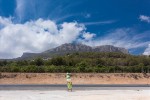Eric Strijbos Utrecht, Netherlands
Eric Strijbos (Amsterdam 1961) is an Utrecht-based travel photographer and travel writer. During a career in book making, photography has gradually become more important; his favorite medium is the photobook. However, he has been involved in exhibitions, and is happy that the Laatikkomo Project brings something of his work back to the streets.
In his autonomous work, he looks for strangeness and irony on a scale between the extremes of architecture and street photography. He is attracted by absence and solitude as well as by touristic crowds or the abundance of commerce.
Eric Strijbos was chosen by photographer Diane Powers.
–––––––––––––––––––––––––––––––––––––
Laatikkomo’s interview with Eric Strijbos January 21st, 2017
L: Where are you from? Or what cities, and/or countries have you lived in – what places have influenced you?
ES: For the most part of my life, I’ve lived in the town of Utrecht, close to Amsterdam, where I went to university to study Greek, Latin and Archaeology. I grew up in Amsterdam and in Ede, a village in the Dutch Bible belt. For my photography, Amsterdam has been the most influential. It’s my default place for projects and shooting when I’m not travelling. On a beautiful day, simply being there can be enough, but I never go without a camera.
For my work as a travel writer and photographer I went to various places, but I spent quite some time in the area around Leipzig and Dresden in eastern Germany. It has tangible sense of history and the large-format photography that I happened to see there inspired me a lot. I also feel connected to Northern France, the area between Lille and Calais; it taught me to look for a kind of understated irony and strangeness-in-the-ordinary.
L: What traits from your own background are apparent in the photography you currently make, or do you consciously consider these influences on your work in any way?
ES: To answer your second question first, I allow for a lot of spontaneity while out shooting, much more than people tend to think, but in the editorial phase, which may take years, I evaluate what happens. I don’t think there’s a need to think about influences very hard. Either influences will do their work, or they don’t. If they don’t, dragging them in by their hairs will be contrived and counterproductive.
Since I was a kid, I’ve read a lot of travel and history books. When I graduated on an architecture subject, the professor said my thesis was also very useful as a travel guide. Still, I never dreamed of ending up writing travel books, but I did. And now, travel and tourism are themes in my photography, which evolved from the work that I did as a travel writer.
The other influence is my time in university. It came with lectures on semiotics, poetics, art history, Renaissance culture, all kinds of artistic concepts etc. I was so lucky to get teachers who taught their students to observe in a methodical way, separating information from interpretation – which is far more exciting that it sounds, because it opens your eyes.
Even before I got trained in architecture photography, I often applied a kind of artificial perspective that was also used in painting from the renaissance, which makes some of my Street scenes look staged or even theatrical, which is contrary to the prevailing Street photography aesthetics.
L: What is your first memory of photography?
ES: When I was six or so, I collected postcards of Amsterdam. They were mostly hand-colored in those days. I didn’t know that at the time, but I remember being aware of the resulting strangeness. I also remember the first time I took a picture with my dad’s camera, some beautiful summer day near a castle, and the ambition to make beautiful photo. Of course, it didn’t come out that brilliant.
In the house, there were pocket books with black and white travel photography by Cas Oorthuys, a humanist square photographer, and books with National Geographic photography.
L: Apart from taking photographs you also write texts and create layout design. Does the process of writing inform your photography or is it the other way around?
ES: Writing has helped my photography at times. Obviously, my work brings me to interesting places. Street and architecture photography, which are required for travel photography, are very important to me. I always wanted to do the photography for my own books, and there was a good photo editor at the publishing house where I’ve published most of my books. Her feedback taught me some of the basics and accidentally nudged me into street photography. (“I need more people!”) At some point, I realized photography was even more important to me than writing, so I took architecture photography courses, started to experiment with all kinds of cameras etc.
L: As a travel photographer, what region of the world are you most drawn to? And where to you hope to travel to next?
I’ve always felt drawn to France, the Alps, Eastern and Southern Europe but I believe I could take pictures anywhere were man has left his imprint, where there’s some story or history. I might get excited by the scruffiness and glaring light of an industrial estate in Spain, some Polish village with too much recent history, or simply a crowd of tourists in Amsterdam. And sometimes places that I can only describe with a Neil Young quote: everybody knows this is nowhere.
My next trip for work is Malta, a great little place. Not very exotic, but it has beautiful architecture, people who enjoy living their life out in the open, and there’s lovely light.
L: Could you list 5 words that you were thinking about when you made this work (shown in Laatikkomo)?
ES: Absence, solitude, observation, travel, irony.
Thank you so much Eric!!






